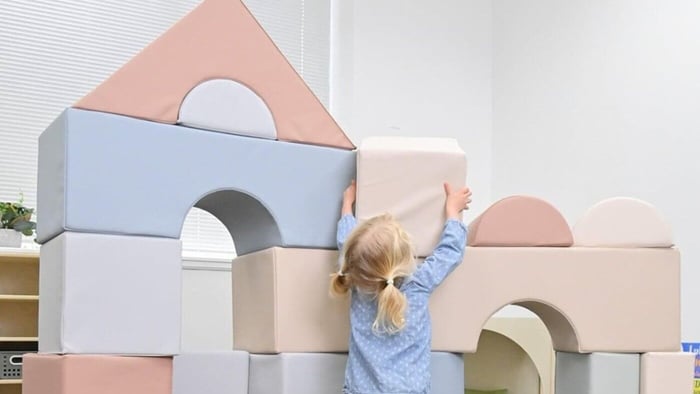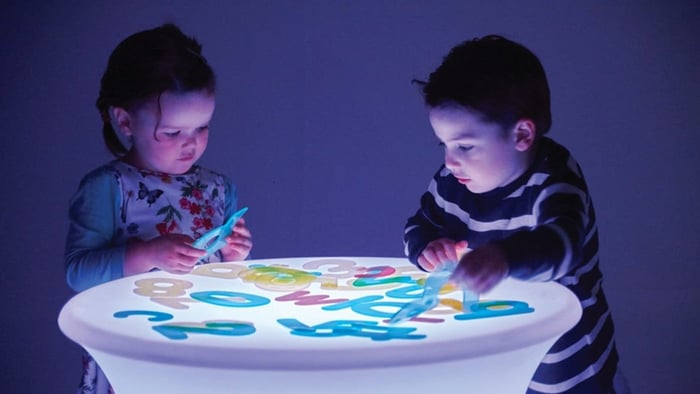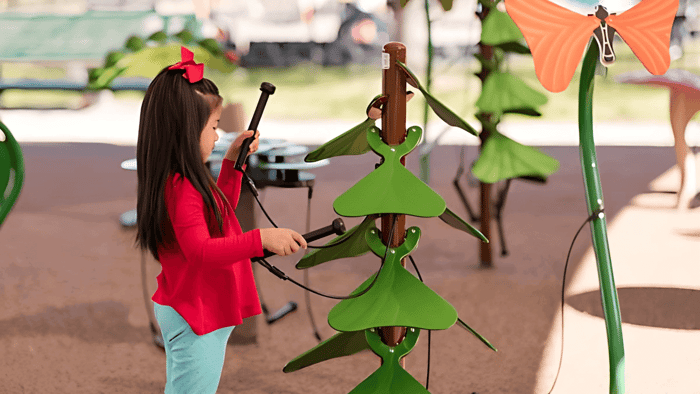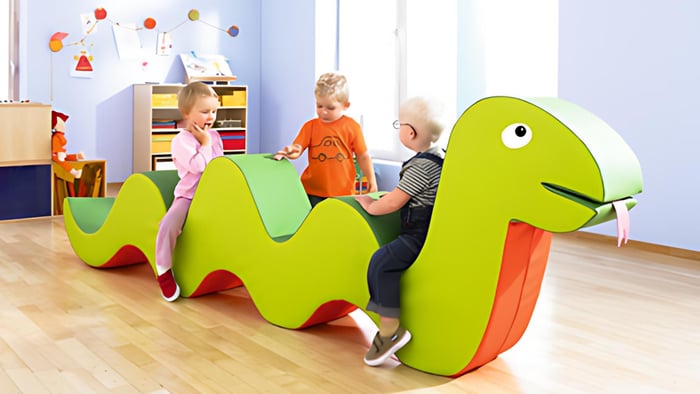
Soft Play Equipment by Age: Toddlers vs. School Age Kids
Table of Contents
- Designing for different developmental stages: toddler soft play features low heights, rounded edges, and soft foam for basic motor skills, while school-age equipment offers taller structures and complex designs that encourage teamwork and physical challenges. Effective multi-age spaces require strategic zone separation for safety.
- Key Takeaways
- Key Developmental Differences Driving Soft Play Design
- Toddler Soft Play Equipment: Safety and Sensory Stimulation
- School-Age Equipment: Challenge and Complexity
- Comparison Table
- Creating Effective Multi-Age Play Environments
- Selecting Equipment That Grows With Your Facility
- FAQs
Designing for different developmental stages: toddler soft play features low heights, rounded edges, and soft foam for basic motor skills, while school-age equipment offers taller structures and complex designs that encourage teamwork and physical challenges. Effective multi-age spaces require strategic zone separation for safety.
Key Takeaways
- Toddler soft play equipment focuses on safety with soft foam materials, low heights, and rounded edges to support basic motor skill development and sensory stimulation.
- School-age soft play features taller structures, more complex designs, and durable materials to encourage physical challenges, teamwork, and problem-solving skills.
- Effective multi-age play spaces need strategic zone separation, distinct themes, and careful traffic flow management to ensure each age group's safety.
- Little People's Cove designs age-appropriate soft play equipment that addresses the unique developmental needs of different childhood stages.
- The materials you choose for your soft play space directly impact both safety and durability—an important investment consideration for any facility.
Key Developmental Differences Driving Soft Play Design
The fundamental differences between toddlers and school-age children shape every aspect of soft play equipment design. Toddlers (ages 0-5) are still mastering basic motor skills like crawling, walking, and climbing. Their play is often solitary or parallel, requiring equipment that supports safe discovery and sensory engagement.
In contrast, school-age children (ages 6-12) have already developed foundational physical abilities and are ready for more complex challenges. Their play becomes increasingly social, competitive, and cooperative, requiring equipment that facilitates group interaction while building advanced coordination, strength, and problem-solving skills.
These developmental distinctions influence everything from material selection to structural design. Little People's Cove creates effective play spaces by recognizing these fundamental differences and designing equipment that precisely matches each age group's capabilities and interests.
Baby Nuts and Bolts Soft Play Climber
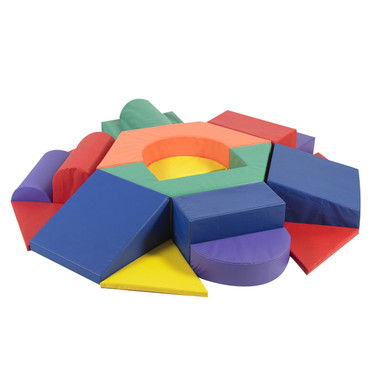
$2,011.63
Introducing the Baby Nuts and Bolts Soft Play Climber, a thrilling playset that will keep little ones entertained for hours! With its 19 brightly colored...… read more
Toddler Soft Play Equipment: Safety and Sensory Stimulation
1. Material Requirements: Soft Foam with Child-Safe Coverings
Toddler soft play equipment prioritizes safety above all else, using specialized materials designed specifically for the youngest users. The foundation of these structures consists of dense polyurethane or polyethylene foam cores that provide cushioning while maintaining structural integrity. These foam elements come wrapped in durable vinyl or polyester-backed vinyl coverings that offer several essential properties.
The coverings must be water-resistant to prevent moisture absorption and microbial growth, especially important given toddlers' tendency to drool and spill. They're also phthalate-free, eliminating potentially harmful chemicals from the play environment. The smooth, seamless surface prevents small fingers from catching on edges while also allowing for quick and thorough sanitization between play sessions.
2. Essential Features: Low Heights, Rounded Edges, and Simplified Structures
Toddler equipment designs reflect an understanding of early physical development with features calibrated to emerging abilities. Heights rarely exceed 12-18 inches, creating challenge without danger. Every edge and corner features generous rounding with no sharp angles or pinch points where tiny fingers might get caught.
Low-height slides with gentle slopes encourage early sliding experiences without intimidation. Crawl tunnels support core strength development while satisfying toddlers' natural curiosity about enclosed spaces. Cushioned steps with minimal rise help little ones practice stair navigation safely. Ball pits filled with soft, oversized balls provide sensory stimulation while eliminating choking hazards.
3. Play Value: Supporting Early Motor Skills and Discovery
Effective toddler soft play goes beyond safety to actively promote development. Equipment arranged in simple circuits encourages crawling, cruising, and early walking attempts. Foam blocks and stackable elements help develop grip strength, hand-eye coordination, and early concepts of cause and effect when stacking and knocking down structures.
Sensory panels with different textures, sounds, and visual elements stimulate cognitive development and sensory integration. Low platforms with multiple access points allow toddlers to practice climbing up and down in a controlled environment. The best toddler soft play installations create a landscape where young children can safely push their boundaries while caregivers enjoy peace of mind.
Chisholm Trail Soft Play Climber
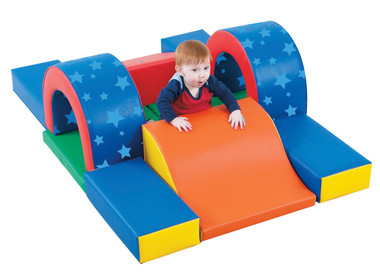
$1,018.88
Chisholm Trail Soft Play Climber combines vivid colors and delightful patterns to beckon all little ones to play! Sculpted to include various tunnels slides and ramps...… read more
School-Age Equipment: Challenge and Complexity
1. Advanced Physical Components: Climbing Structures and Obstacle Courses
School-age soft play equipment shows a significant increase in design complexity, reflecting the developmental growth children make between ages 6 and 12. These structures include vertical elements with climbing walls, rope nets, and multi-level platforms that can reach heights of 6-8 feet or more. Unlike toddler equipment, which makes everything accessible, school-age designs intentionally introduce controlled difficulty.
Obstacle courses form a central feature of many school-age installations, with sequences of challenges that build progressive physical skills. These might include balance beams, hanging steps, rolling logs, and gaps that require planning and coordination. The focus shifts from basic movement mastery to building advanced physical literacy, agility, and strength.
Little People's Cove designs their school-age equipment to provide this perfect balance of challenge and safety, creating environments where older children can test their limits while parents maintain peace of mind.
2. Material Construction: Durable Frames with Protective Padding
The construction of school-age equipment reflects the increased physical demands placed upon it. Internal frames typically utilize galvanized steel or similarly robust materials that can withstand the dynamic forces generated by larger, more active bodies. These frames create the skeleton for climbing structures, platforms, and connective elements like bridges and tunnels.
Protective padding uses denser, more compression-resistant foam than toddler equipment. This padding is covered with heavy-duty PVC tarpaulin or similar materials that resist tearing, abrasion, and moisture. The covering materials must balance durability with appropriate surface friction – enough grip for safe climbing but smooth enough to prevent abrasions during slides and fast movement.
Netting elements constructed from woven nylon or polyester provide both safety barriers and climbing challenges. The interconnections are reinforced and designed to maintain structural integrity even with multiple users. Structural plastics used in tunnels, slides, and decorative elements are typically engineering-grade with UV stabilizers to prevent degradation in outdoor settings.
3. Interactive Elements: Problem-Solving and Cooperative Play Features
Modern school-age soft play incorporates interactive elements that engage children cognitively as well as physically. These might include simple machines like pulleys to move soft objects between levels, gear walls that demonstrate mechanical principles, or ball runs that teach cause and effect relationships.
Cooperative features encourage social development through shared challenges. Examples include:
- Two-person balance platforms that require coordinated movement
- Ball runs that need multiple participants to function effectively
- Large soft building blocks that require teamwork to construct significant structures
- Soft maze elements that encourage communication and strategy
These elements reflect school-age children's increasing social awareness and capacity for collaborative problem-solving. They transform play from parallel activities to truly interactive experiences that build communication skills and emotional intelligence.
4. Spatial Design: Multi-Level Configurations and Challenging Pathways
The spatial arrangement of school-age soft play creates three-dimensional landscapes that encourage strategy and thinking. Vertical space becomes as important as horizontal footprint, with routes that move children up, down, and across in complex patterns. This three-dimensionality maximizes play value within limited square footage while creating more engaging challenges.
Pathways often include multiple routes of varying difficulty, allowing children to choose challenges appropriate to their skill level or to progressively master more demanding options. Dead ends and controlled bottlenecks create opportunities for problem-solving and social negotiation as children navigate shared space.
While meeting strict safety standards, school-age design introduces controlled risk – the perception of challenge without actual danger – that helps children develop risk assessment skills and confidence in their physical abilities. All equipment must meet or exceed applicable safety guidelines, including ASTM F1918 standards for soft contained play equipment.
Comparison Table
Creating Effective Multi-Age Play Environments
Physical Separation: Strategic Barriers and Zone Placement
When designing soft play spaces that serve both toddlers and school-age children, physical separation provides the foundation for safe, age-appropriate play. Low walls, half-height fencing, or strategically placed play elements can create natural boundaries between zones without completely isolating groups from each other. These barriers should be substantial enough to prevent accidental crossover but permeable enough for visual supervision.
Flooring transitions offer another effective separation strategy. Different colors, textures, or materials visually signal zone changes while potentially providing appropriate impact attenuation for the activities in each area. A toddler zone might feature extra-padded flooring in bright colors, while school-age areas could use firmer surfaces in contrasting hues.
Thoughtful placement considers family dynamics by positioning toddler zones where they can be easily supervised from seating areas, while placing more active school-age zones farther from quiet spaces. This arrangement acknowledges that families often include children of multiple ages who need to play simultaneously but separately.
Visual Cues: Color-Coding and Thematic Differentiation
Beyond physical separation, visual differentiation helps children intuitively understand which areas are designed for them. Consistent color schemes create clear visual identity for each zone – perhaps warm, primary colors for toddler areas and cooler, more complex color palettes for school-age sections. These color differences should extend across all elements within each zone, from flooring to equipment to wall graphics.
Thematic differentiation further reinforces age appropriateness. Toddler zones might feature simple, recognizable themes like:
- Friendly farm animals with soft tactile elements
- Underwater adventures with gentle wave-shaped climbing forms
- Enchanted gardens with mushroom-shaped seating and flower-themed sensory panels
School-age areas can incorporate more complex thematic elements like jungle expeditions with multi-level climbing structures, space stations with interconnected pods, or medieval castles with challenging climbing walls and secret passages.
Signage also plays an important role, with clear, graphical indicators of age recommendations. These visual cues help both children and caregivers identify appropriate play spaces without creating a sense of rigid restriction or exclusion.
Play Elements for Play Corner Mats
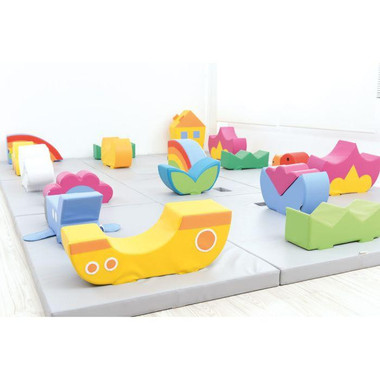
$55.55
Colorful play elements are made of durable foam covered with durable PVC fabric, easy to keep clean. Play elements can be freely exchanged and combined...… read more
Traffic Flow: Designing Safe Movement Between Areas
Good traffic flow management prevents dangerous collisions between differently sized and skilled users. Entry and exit points for each zone should be distinct and clearly marked, with toddler zones typically positioned closer to the overall entrance for easy access with young children. Circulation paths should be wide enough to accommodate both children and accompanying adults, with sightlines that allow visual supervision throughout.
Buffer zones between areas with significantly different activity levels provide transitional spaces that help children modulate their energy and movement styles. These might include:
- Reading nooks with soft seating and tactile wall elements
- Simple building stations with foam blocks that appeal to multiple age groups
- Open areas with gentle features that don't encourage running or jumping
Strategic placement of parent seating facilitates supervision across multiple zones, allowing families with children of different ages to maintain visual contact with all their children while respecting the integrity of age-specific areas. These seating areas should offer clear sightlines into both toddler and school-age spaces without being directly in the path of active play.
Selecting Equipment That Grows With Your Facility
Making smart investments in soft play equipment means considering not just immediate needs but how the space will function over time. Modular systems offer flexibility, with components that can be reconfigured or expanded as needs change. For example, a basic climbing structure might start with simple steps and a small slide for younger users, then later be expanded with challenging climbing nets and higher platforms as your demographic shifts toward older children.
Core structures with multiple attachment points provide excellent adaptability. These foundational pieces can support different accessories—from simple sensory panels appropriate for toddlers to complex climbing attachments that challenge school-age children. This approach creates a framework that evolves without requiring complete replacement.
When selecting equipment for multi-age settings, prioritize pieces that offer scalable challenge. A well-designed climber might include both a gentle ramp for beginners and a more challenging rope ladder to the same platform. Ball pits can feature varying depths in different sections, accommodating different age groups safely within the same feature.
Material quality significantly impacts longevity and value. High-density foams maintain their shape and support through years of active use. Commercial-grade vinyl coverings with reinforced seams resist tearing and splitting even under heavy traffic. Antimicrobial treatments on surfaces extend usable life while promoting hygiene in high-touch environments.
Consider future maintenance requirements when evaluating options. Removable, washable covers for frequently touched elements make regular cleaning more practical. Modular construction allows for replacement of individual components rather than entire structures when wear occurs. These features may add to initial cost but significantly reduce long-term ownership expenses.
Successful soft play spaces adapt alongside the children who use them, offering fresh challenges and experiences that match developing abilities. By carefully selecting equipment with growth potential, facility operators create environments that remain engaging and relevant year after year, maximizing both developmental benefits for children and return on investment.
Understanding the fundamental differences between toddler and school-age equipment design is essential for creating spaces that truly serve children's developmental needs. From material selection to spatial arrangement, each decision should reflect the specific requirements of the intended users. When thoughtfully implemented, these age-appropriate distinctions create environments where all children can safely challenge themselves and grow through play.
Little People's Cove specializes in creating innovative soft play environments that address the unique needs of different age groups while offering the flexibility to adapt over time.

